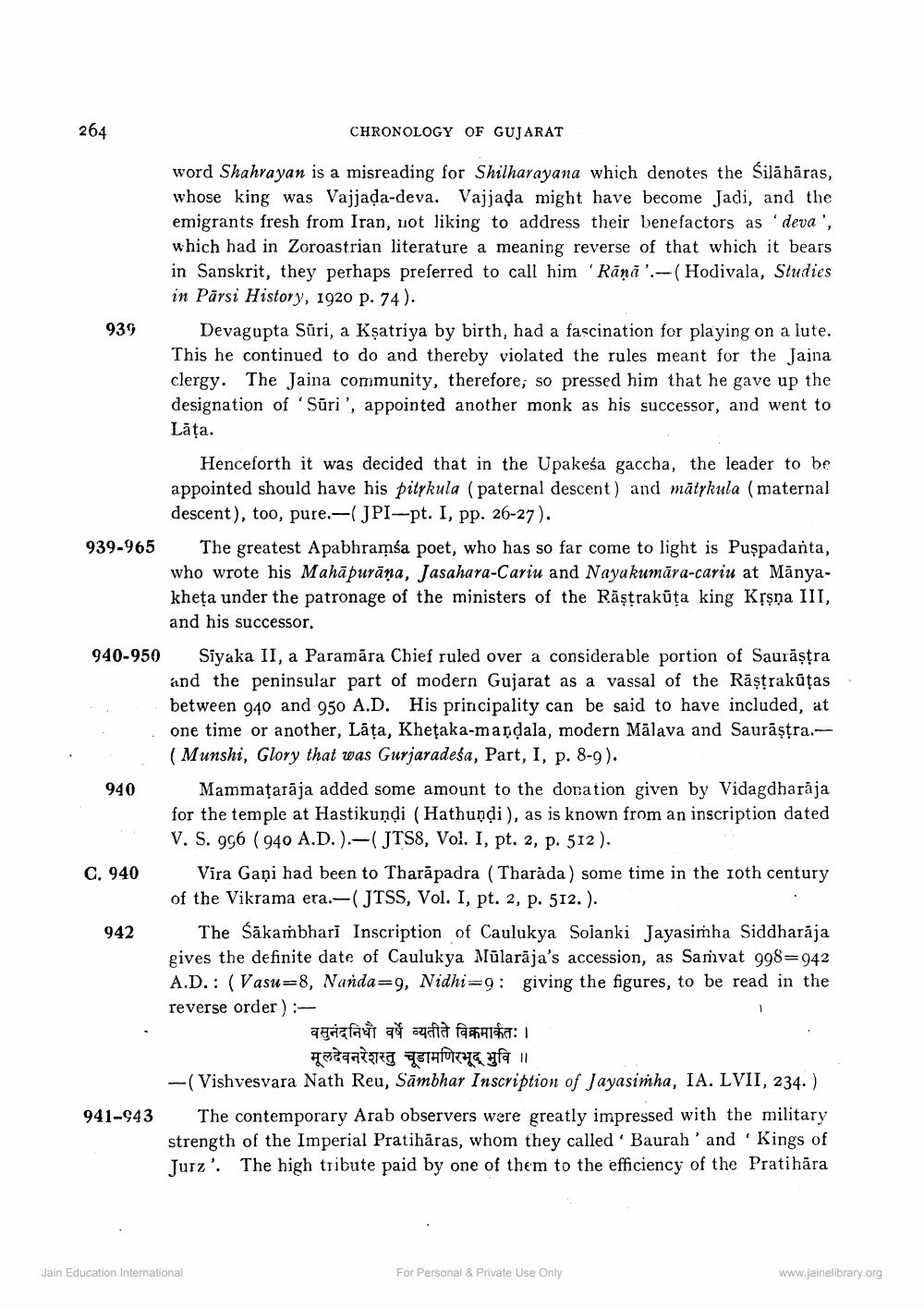________________
264
939
939-965
940-950
940
C. 940
942
941-943
CHRONOLOGY OF GUJARAT
word Shahrayan is a misreading for Shilharayana which denotes the Silähāras, whose king was Vajjada-deva. Vajjada might have become Jadi, and the emigrants fresh from Iran, not liking to address their benefactors as 'deva', which had in Zoroastrian literature a meaning reverse of that which it bears in Sanskrit, they perhaps preferred to call him 'Rand.-(Hodivala, Studies in Parsi History, 1920 p. 74).
Devagupta Sūri, a Kṣatriya by birth, had a fascination for playing on a lute. This he continued to do and thereby violated the rules meant for the Jaina clergy. The Jaina community, therefore, so pressed him that he gave up the designation of 'Suri', appointed another monk as his successor, and went to Läta.
Henceforth it was decided that in the Upakeša gaccha, the leader to be appointed should have his pityhula (paternal descent) and matykula (maternal descent), too, pure.-(JPI-pt. I, pp. 26-27).
The greatest Apabhramsa poet, who has so far come to light is Puspadanta, who wrote his Mahapurana, Jasahara-Cariu and Nayakumara-cariu at Manyakheta under the patronage of the ministers of the Rāṣṭrakūta king Krsna III, and his successor.
Slyaka II, a Paramāra Chief ruled over a considerable portion of Saurāṣṭra and the peninsular part of modern Gujarat as a vassal of the Rāṣṭrakūtas between 940 and 950 A.D. His principality can be said to have included, at one time or another, Lâța, Khetaka-mandala, modern Mälava and Saurastra.(Munshi, Glory that was Gurjaradeśa, Part, I, p. 8-9).
Mammațarăja added some amount to the donation given by Vidagdharaja for the temple at Hastikundi (Hathundi), as is known from an inscription dated V. S. 996 (940 A.D.)-(JTS8, Vol. I, pt. 2, p. 512).
Vira Gapi had been to Tharapadra (Tharada) some time in the 10th century of the Vikrama era.-(JTSS, Vol. I, pt. 2, p. 512. ).
The Sakambharl Inscription of Caulukya Solanki Jayasimha Siddharāja gives the definite date of Caulukya Mūlaraja's accession, as Samvat 998-942 A.D. (Vasu 8, Nanda 9, Nidhi-9: giving the figures, to be read in the reverse order) :
वसुनंदनिधौ वर्षे व्यतीते विक्रमार्कतः । मूलदेवनरेशस्तु चूडामणिरभूद् भुवि ॥
-(Vishvesvara Nath Reu, Sambhar Inscription of Jayasimha, IA. LVII, 234.)
The contemporary Arab observers were greatly impressed with the military strength of the Imperial Pratihāras, whom they called Baurah and Kings of Jurz. The high tribute paid by one of them to the efficiency of the Pratihara
Jain Education International
For Personal & Private Use Only
www.jainelibrary.org




